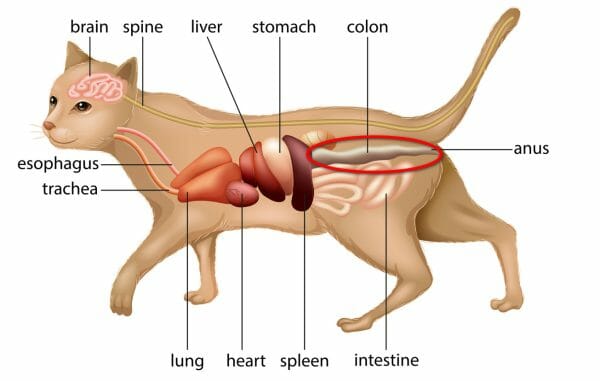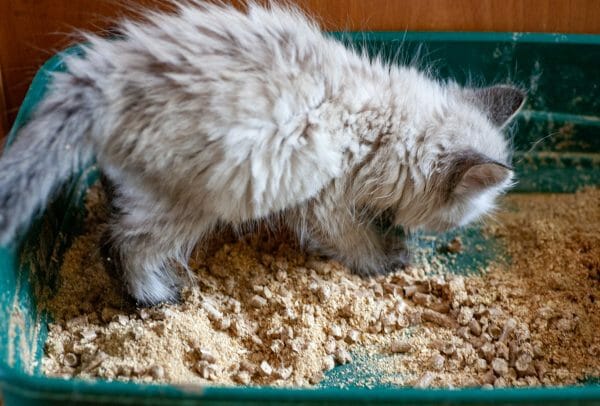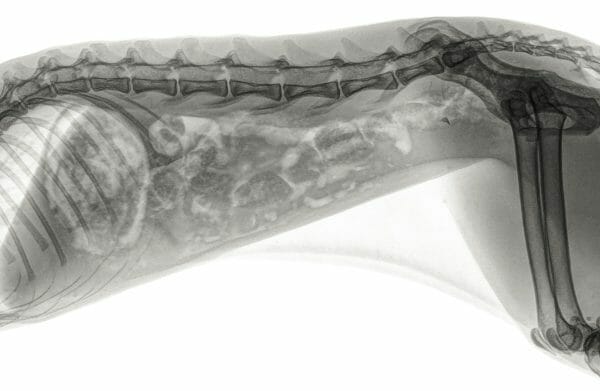What Is Megacolon in Cats?
Megacolon in cats is a condition that affects the nerves and muscles of the colonic wall. A cat’s gastrointestinal tract ends at the large intestine with the colon. The purpose of the colon is to absorb water and store fecal matter. At the end of the colon is the rectum. The colon’s walls are made up of muscles. These muscles are meant to contract by the nerves in the cat’s spinal cord. As the colon is made to contract, feces are excreted from the rectum.
When a cat has megacolon, the muscles in the colon wall do not contract. As a result, they will stretch, and the colon will expand. An enlarged colon will often expand to up to four times its normal size. Instead of pushing out feces, it will be accumulated in the now distended colon. The build-up of fecal matter leads to severe constipation, which is known as obstipation.

Causes of Megacolon in Cats
Megacolon may start as mild or moderate constipation. Over time, if this is not treated, it may develop into chronic constipation or megacolon. Any condition that creates a blockage or build-up of stool in the large intestine could cause megacolon.
Some common causes of megacolon in cats include:
- Arthritis
- A cancerous tumor in the colon
- Trauma
- A foreign body (such as a fragment of bone stuck in the gastrointestinal tract)
- Hernias
- Chronic kidney disease
- Diabetes mellitus
Where the exact cause cannot be determined, the condition is referred to as an idiopathic megacolon. Manx cats (which are born without a tail) may have a deformed area in their spine. Known as the sacrum, this can cause megacolon in this particular breed of feline.

Cat Megacolon Symptoms
Cats that suffer from megacolon are typically between 5 and 9 years old. It can be difficult to spot the signs of the condition in cats, particularly when the feline goes to the toilet outside. Keeping an eye on a cat’s bowel habits can be a challenge.
Usually, cats will make a bowel movement at least once a day. The following symptoms may indicate that a cat has megacolon:
When a cat has megacolon, there will be a large amount of firm stool in the colon. The feces can be felt by pressing on the cat’s abdomen. It is important that if any of the symptoms of megacolon are present, the cat is assessed by a veterinarian to ensure that there are no signs of the following:
- Masses (such as tumors or foreign bodies obstructing the colon)
- Hernias in the colon or rectum
- Pelvic fractures

Diagnosing Megacolon in Cats
Cats that are most prone to megacolon are usually male, middle-aged, domestic shorthairs. While suffering from constipation, stools will either be smaller than usual or completely absent. Cats that are affected by megacolon will pass large hard and dry stools between one and three times each week.
A veterinarian will diagnose megacolon using the cat’s clinical history as a guide, along with a physical examination. This examination will be looking for evidence that the colon is distended with feces. A digital rectal examination will be carried out to look for obstructions in the pelvic canal.
To rule out other conditions (such as a tumor), an X-ray will be carried out of the cat’s abdomen. Following this, an abdominal ultrasound may also be performed alongside a colonoscopy. This will provide the veterinarian with the further information needed to identify the underlying cause.
If a kitten presents with megacolon, a blood test will be carried out. This will help rule out problems with the thyroid gland.

Megacolon in Cats Treatment
If a cat has megacolon, dehydration will very likely occur. To address this, a veterinarian will administer fluids intravenously. In addition, enemas and manual stool removal may be performed to completely clear the colon. This will be done under general anesthetic.
A veterinarian may prescribe lubricating agents or laxatives for cats with the condition. This will help soften and lubricate the stool so that the bowels can move freely. A veterinarian may also prescribe Cisapride to aid the colon’s motility.
When a cat has a recurring distended colon and requires hospitalization repeatedly for manual stool removal, surgery will be recommended. Megacolon surgery for cats involves the removal of the cat’s colon. Once removed, the cat’s small intestine will be joined surgically with the rectum. In addition, intravenous fluids will be administered along with electrolytes and plasma. Following the removal of a colon, the cat will typically be able to return home on the same day.

Cat Megacolon Home Remedies
In the first instance, it is always recommended that a cat suffering with constipation is taken for assessment with a veterinarian. To aid a cat with megacolon, here are some measures you can take with the home.
- Diet. The best cat food for megacolon will be one with a high fiber content. Adding a small amount of canned pumpkin puree to a cat’s meal will also aid bowel movements.
- Hydration. Staying hydrated is important for cats with megacolon. Make sure there is ample fresh water supplied in clean bowls. Many cats are particular about where they drink from and prefer running water. For this reason, it may help to use water fountain designed for cats.
- Clean Litter Box. Pay attention to the cleanliness of the cat’s litter box as many cats will avoid using it if it has been soiled. Frequent cleaning is also essential, as is using litter that the cat likes.
Megacolon in Cats Prognosis
Many cat owners ask “how long can a cat live with megacolon?” Fortunately, megacolon is not a condition that will shorten a cat’s lifespan. However, recovery will vary in length and will be largely depend on the specifics of the case. When muscle function is restored and the constipation is resolved, the prognosis will be good.
In situations where the condition reaches the point where surgery is necessary, recovery time will be longer. For the first three months following surgery, the cat may have frequent loose bowel movements. If there are no complications following surgery, the outlook will be positive.



